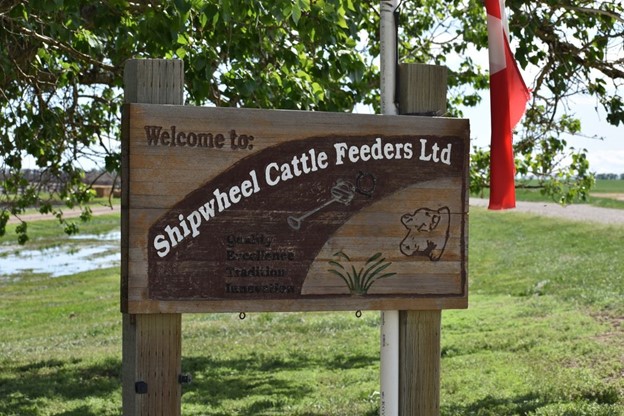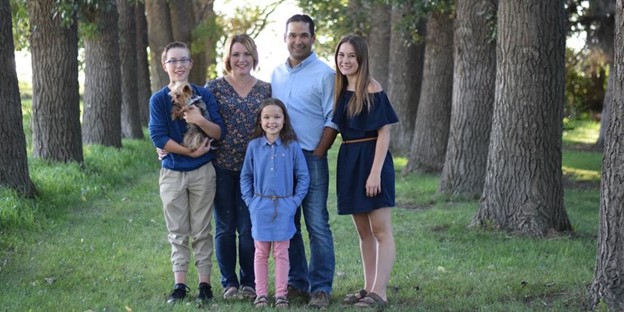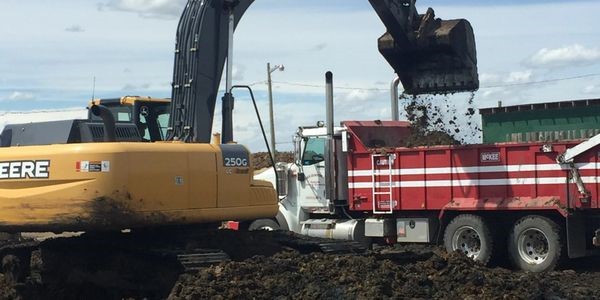
Alltech Canada Planet of Plenty Award Winner:
Shipwheel Cattle Feeders
Holistic management for sustainable beef cattle production
Andrea Stroeve-Sawa and Shipwheel Cattle Feeders Ltd. are winners of the Alltech Canada Planet of Plenty award, which recognizes farmers, producers and ranchers who are harnessing the power of agriculture to create a Planet of Plenty™. To read more inspiring stories and learn more about Alltech’s vision of Working Together for a Planet of Plenty™, visit planetofplenty.com.
When Albert Damgren (Green), the eldest of three sons, was 12 years old, a famine hit Sweden. He soon learned how the famine would impact his family and came to realize that someone must take another job in order for the family to survive. Deciding to take matters into his own hands, Albert woke in the middle of the night, went to the docks and boarded a ship headed for America to save his family.
Today, Andrea Stroeve-Sawa, Albert’s great-granddaughter, manages Shipwheel Cattle Feeders Ltd., and she and the Holtman family are carrying forward their own legacy of bravely taking risks. Currently, the family operation includes a yearling grazing program, a 5,500-head cattle feedlot, bees, pasture-raised chickens, a no-till “chaos” garden, a fruit orchard and compost production.
Throughout the generations, Shipwheel Cattle Feeders has maintained an unwavering dedication to continually improving its land base, the animals entrusted to its care and the community. All management decisions are made with one important goal in mind: they must be congruent with its purpose while building its future resource base and improving quality of life. Shipwheel is a place of continual learning, where curiosity and innovation are complemented by thoughtfulness and planning, setting the stage for expanding the general knowledge of regenerative agriculture practices.
Detailed below are several ideas that Andrea and Shipwheel have implemented to support their operation and sustainable beef cattle production.

Shipwheel Cattle Feeders Ltd.

Andrea Stroeve-Sawa and Family

Andrea Stroeve-Sawa

Andrea Stroeve-Sawa

Shipwheel Cattle

Shipwheel Cattle

Shipwheel Cattle

Shipwheel Cattle

Shipwheel Cattle

Shipwheel Cell 2 – 1978

Shipwheel Cell 2 – 2015
Holistic management: Increasing land productivity
“Since birth, I have been immersed in using the principles of holistic management,” said Andrea. “I basically learned holistic management through osmosis.”
At the early age of 6 months old, Andrea attended her first holistic management course with her parents, which was held by Alan Savory in the 1980s. Upon the family’s return from the course, they transformed their existing continual grazing operation into 65 different paddocks and three different grazing cells. In the early 1980s, this was an audacious move.
“(My parents) were criticized; they were told it wasn’t going to work — they were told they were crazy — but they just did it anyway,” said Andrea.
A few years ago, Andrea was renegotiating a new surface lease for one of their oil sites.
“We weren’t really happy with the new lease rate increase that was offered (to) us for our dry grassland,” she explained. “After a lengthy ‘friendly disagreement’ regarding the offer, I decided to look into the suggested Ecologically Sustainable Stocking Rate on land in our area (with) our soil type. I knew that our land was more productive than the neighbouring land but (had) never taken the time to quantify it.”
After doing some research, Andrea discovered that they were currently stocking cattle at six times the suggested Ecological Sustainable Stocking Rate, and their land was still improving.
“Now that I had that information, it really got me thinking,” said Andrea. “We had always known that the increase in productivity since we began practicing holistic management on our grassland in 1982 was a lot but had never really quantified it. We knew we were better than average; the physical look of the land, the water cycle and the mineral cycle told us it was more productive. But what really intrigued me (was): how much had we improved the land over the years?”
Andrea made it her new project to dig out all the faded, yellow grazing charts and pictures from the past to see if she could quantify their land improvement.
“It was a painstaking process, but what we found was astounding,” she said. “What we learned was that, from when we started keeping records in 1982 until the present, we had increased the productivity of our land, ranging from 261% to 3,862%.”

Shipwheel composting feedlot waste

Shipwheel composting feedlot waste

Shipwheel vermicompost

Shipwheel vermicompost

Shipwheel vermicompost packaged for customers
Upcycling feedlot waste
Fifteen years ago, Andrea’s father took a composting class. He came home and started to compost the 20,000 metric tons of manure and bedding from the feedlot to produce an upcycled feedlot waste product.
“Every year, in the spring, we clean our pens and put the manure, bedding and whatever other green material we can get our hands on into windrows on our (National Resource Conservation Board)-approved compost pad,” explained Andrea. “On average, we haul out about 10,000 wet metric tons that will turn into approximately 5,000 dry metric tons for us to sell.”
Andrea knows that making good compost is more of an art form than a scientific process. The team observes and monitors the temperatures of the rows, and when they get to 150–160 degrees Fahrenheit, they turn them with a compost turner. In Taber, Alberta, Canada, they are surrounded by very high-value irrigated land that is used to grow high-value crops such as corn, onions, potatoes, pumpkins and canola. Because of their proximity to this land, they can sell a high-value byproduct to the farmers.
“We see the compost as a tool to (impact) many acres of land,” said Andrea. “Over the last few years, we have seen that the demand for compost has increased to the point that we can’t meet demand with our current supply.”
Compost helps increase the biological health of the soil, and it also helps decrease the need for synthetic fertilizer. In 1 teaspoon of compost, there are 100 billion microbes, which the customer receives for free.
“We will also sell small amounts of compost to members of our community as a community outreach project,” noted Andrea. “We like the thought of two neighbours comparing gardens (and) saying, ‘Oh, that Shipwheel compost made some great big tomatoes.’ It gives them good feelings about Shipwheel in their community and about regenerative agriculture.”
Using effective stockmanship to maintain healthy cattle
In 2014, Shipwheel was approached by a customer that wanted to feed cattle without added hormones or antibiotics. The knowledge, skill and cattle handling principles taught by Bud Williams were at the forefront of this opportunity.
The revolutionary stockmanship that Bud taught was named one of the “Top Ten Innovations” in the beef industry, alongside barbed wire, antibiotics and refrigeration, by Beef Producer in 2011. In the September 2013 issue of Beef, he was named one of the top 50 industry leaders. Bud’s stockmanship, feeding high-quality feed and focusing on individual animal care aligned with Shipwheel’s new customer and its needs. Shipwheel took the knowledge of cattle handling that Bud taught and used it to help boost depressed immune systems and maintain healthy cattle.
“Cattle are herd animals,” explained Andrea. “They far prefer to move as a herd. Our job as caregivers or handlers of the cattle is to gain the trust of the herd through our posture, position, distance and angles while handling. When the cattle have confidence in us as their caregivers, we are then actually able to take the herd for a walk.”
“Proper exercise for the herd releases their stress, which will decrease (their) cortisol response, thus increasing the suppressed immune system and breaking the negative cycle of stress,” she continued. “Just as humans would reduce stress through movement individually — by going for a walk, for example — cattle can release stress with proper exercise, but (they) need to do this as a herd as opposed to individually.”
In 2017–2018, Shipwheel fed more than 3,500 cattle that were ranch direct. The average weight of the heifers was 451 pounds, and the average weight of the steers was 508 pounds. They were not treated with antibiotics on arrival, were not fed ionophore, and did not receive implants. Only 4.74% of the heifers and 6.06% of the steers were treated with antibiotics by the time they weighed 850 pounds.
“I am so grateful for what we learned in those years while feeding cattle without the mass use of antibiotics,” said Andrea. “We can directly apply those same stockmanship principles to the conventional cattle that we are feeding now. Every member of the Shipwheel crew is required to understand the concepts of cattle handling that Bud taught us and be continually practicing and applying those stockmanship principles to the best of their ability.”
Regeneration of the land
A few years ago, Shipwheel had an office administrator who was very keen to learn about bees, so Andrea gave her a budget, and she set out to add a pollinator enterprise at Shipwheel.
“We did have some Shipwheel honey this year and are hoping for a little more next year, as now, their hives are established,” said Andrea. “This enterprise contributes more to the community dynamics of the ecosystem and the social part of Shipwheel than to the financial wing of the whole operation, but it was minimal risk.”
“The more we learn about the bees, we realize they are fascinating insects!” she continued. “Our staff loves the bees, and it does wonders for our morale. The bees and the compost really fit in with our goals of (the) regeneration of the land and, at the same time, building community.”

Shipwheel bees and honey

Shipwheel bees and honey

Shipwheel bees and honey

Shipwheel bees and honey

Shipwheel bees and honey
Collaboration for a stronger operation and community
Shipwheel’s management style is unique and inclusive, welcoming constant input from both its owners and staff. March 2020 found the business facing a global pandemic. Andrea took a collaborative approach with staff members and created a “brainstorming wheel,” which illustrated how they needed new enterprises to increase diversity — but the new enterprises also had to fit within their bigger overall, holistic goal.
“The brainstorming wheel worked, and amidst a global pandemic, we added five enterprises to our (operation),” explained Andrea. “We added vermicomposting, a fruit orchard, a chaos no-till garden (and) pastured chickens, and we started making high-fungal compost. We are hoping to expand and grow these enterprises in the coming years to become more diversified and have stability and profit spanning all seasons.”
Collaboration is ingrained in the structure of Shipwheel.
“When the pandemic hit, I was concerned for my own business, but I was also concerned for the small businesses in our small community that had to suddenly shut their doors,” said Andrea. “We decided that Shipwheel would start our own ‘small business challenge.’”
Every week, someone on Shipwheel’s staff would pick a local small business from whom to purchase a $100 gift certificate, and then the team conducted a social media drawing to pick a winner to receive the gift certificate.
“In a world that felt completely out of our control, this was a small way that we felt we could make a difference,” said Andrea. “This was another small example of our entire team contributing to the morale of our community.”

Chaos Garden

Chaos Garden
Carbon sequestration: Agriculture as a solution
Andrea is passionate about increasing the storage of carbon in the soil.
“I am very grateful to Dr. Kris Nichols (a Soil Microbiologist) and Kim Cornish (Director of Food Water Wellness Foundation),” she said. “These two outstanding women leaders have helped me learn about soil health, mycorrhizal fungi, glomalin and its role in storing carbon and building soil aggregates.”
Shipwheel has been involved in a study of technology that measures carbon in the soil. Shipwheel hopes that by forming an alliance with organizations that are developing a carbon measurement system, it can put a value on the carbon that it has been sequestering.
Grassland in the area is under threat of conversion to cultivated land. By maintaining the grassland, keeping the carbon in the soil and putting a value on that carbon in the soil, Shipwheel will potentially be able to increase its income per acre in order to compare with high-value cultivated crops, such as potatoes.
Early indications from its participation in the study show that Shipwheel has stored an estimated minimum of 230 MT of CO2 equivalent per hectare and as high as 800 MT of CO2 equivalent per hectare.
The current Canadian federal government has committed to reducing greenhouse gas (GHG) emissions to 30% below the 2005 levels by 2030. “What if the cattle feeders, the beef producers and the agriculture industry were the solution to that?” asked Andrea.
Working Together for a Planet of Plenty™
“I feel that I have a huge responsibility to the previous generations to care for this tiny piece of the Earth, make it better and then pass it down to the future generations to contribute to a planet of plenty,” said Andrea. “What I am hoping for my own children is to have the courage and passion like (great-grandpa) Green to be brave and go for it! I want them to feel so deeply about something, to be bold and try something new, even if the world is telling them it can’t be done, and I would like them to couple that with a desire to construct, to add to, to regenerate, to build, rather than degrade, destroy or do nothing.”
“And so, how can I help with that?” she continued. “I can model it within my own life and through my leadership at Shipwheel and within the agriculture industry. I have had the opportunity to be a steward of the land, and I can continue to learn and grow and build, regenerate, add to and construct.”
At Alltech, we are Working Together for a Planet of Plenty™. A planet where science-based solutions help ensure sustainable food production for the global population. A planet where agriculture’s story is central to the development of thriving communities and ecosystems. A planet where, through collaboration and innovation, we can create a world of abundance for future generations.
The entry deadline was April 1, 2021.
The winners will be contacted by April 30, 2021.
At Alltech, we are Working Together for a Planet of Plenty™. A planet where science-based solutions help ensure sustainable food production for the global population. A planet where agriculture’s story is central to the development of thriving communities and ecosystems. A planet where, through collaboration and innovation, we can create a world of abundance for future generations.
The Alltech Canada Planet of Plenty Award is now closed!
Sharing a Planet of Plenty
The moment is now for Canadian agriculture to unify and work towards a vision of promise, possibility, and positivity for the future. We all have a role to play in sustainability’s story.
What are you doing to make a Planet of Plenty possible? Tell us your story.




